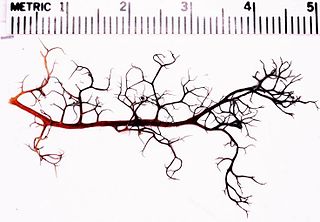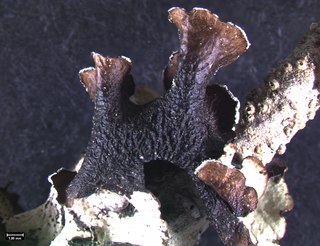
Parmelia is a genus of medium to large foliose (leafy) lichens. It has a global distribution, extending from the Arctic to the Antarctic continent but concentrated in temperate regions. There are about 40 species in Parmelia. In recent decades, the once large genus Parmelia has been divided into a number of smaller genera according to thallus morphology and phylogenetic relatedness.

The Parmeliaceae is a large and diverse family of Lecanoromycetes. With over 2700 species in 71 genera, it is the largest family of lichen-forming fungi. The most speciose genera in the family are the well-known groups: Xanthoparmelia, Usnea, Parmotrema, and Hypotrachyna.

Ahtiana is a fungal genus in the family Parmeliaceae. A monotypic genus, it contains the single species Ahtiana sphaerosporella, the mountain candlewax lichen, found in western North America. The species was originally classified as Parmelia sphaerosporella by Johannes Müller Argoviensis in 1891, before Trevor Goward established the new genus Ahtiana in 1985, naming it after Finnish lichenologist Teuvo Ahti. This foliose lichen is characterised by its pale yellowish-green thallus, spherical spores, laminal apothecia, and the presence of usnic and caperatic acids. It primarily grows on the bark of whitebark pine in subalpine and montane regions, though it occasionally colonises other conifers outside its preferred host's range.

Hypogymnia is a genus of foliose lichens in the family Parmeliaceae. They are commonly known as tube lichens, bone lichens, or pillow lichens. Most species lack rhizines that are otherwise common in members of the Parmeliaceae, and have swollen lobes that are usually hollow. Other common characteristics are relatively small spores and the presence of physodic acid and related lichen products. The lichens usually grow on the bark and wood of coniferous trees.

Cetrelia is a genus of leafy lichens in the large family Parmeliaceae. They are commonly known as sea-storm lichens, alluding to the wavy appearance of their lobes. The name of the genus, circumscribed in 1968 by the husband and wife lichenologists William and Chicita Culberson, alludes to the former placement of these species in the genera Cetraria and Parmelia.

Gowardia is a genus of medium-sized, greyish hair lichens in the family Parmeliaceae. It is a circumpolar genus, mainly restricted to arctic-alpine habitats in northern Canada, Europe, and Russia.

Bryoria is a genus of lichenized fungi in the family Parmeliaceae. Many members of this genus are known as horsehair lichens. The genus has a widespread distribution, especially in boreal and cool temperate areas.

Platismatia wheeleri is a species of foliose lichen in the family Parmeliaceae. Found in western North America, it is characterized by its whitish, smooth thallus and asexual reproduction through soredia. This lichen species is primarily found in western intermontane North America, from southern British Columbia to Washington, Idaho, and Oregon. It has also been discovered in southern California and the Tatra Mountains of Slovakia.
Bryoria hengduanensis is a species of lichen of the genus Bryoria. It was described as new to science in 2003 by lichenologists Li-Song Wang and Hiroshi Harada. It is found in the Hengduan Mountains of southern China, where it grows on twigs and branches in coniferous forests at elevations of 3,000–4,000 metres (9,800–13,100 ft). The Hengduan Mountains is a region of high Bryoria biodiversity, as 24 species are known from this area.
Teuvo ("Ted") Tapio Ahti is a Finnish botanist and lichenologist who has made significant contributions to the taxonomy and biogeography of lichens. Known particularly for his work on the lichen family Cladoniaceae, he has had a long career at the University of Helsinki beginning in 1963, and following his retirement in 1997, has continued his research at the Botanical Museum of the Finnish Museum of Natural History. His research output spans more than seven decades, comprising over 450 scientific publications across lichenology, mycology, and botanical science.
Bryoria implexa is a species of horsehair lichen in the family Parmeliaceae.
Bryoria kockiana is a species of horsehair lichen in the family Parmeliaceae. It is found in North America, where it grows from the branches of conifer trees.
Parmelia imbricaria is a species of foliose lichen in the family Parmeliaceae. Found in western Canada, it was formally described as a new species in 2017 by Trevor Goward, Pradeep Kumar Divakar, María del Carmen Molina, and Ana Crespo. The type specimen was collected by Goward near the Clearwater River drainage, where it was found at an elevation of 700 m (2,300 ft) growing on a basalt boulder. The specific epithet refers to the "imbricate" lobes of the thallus. The lichen occurs in western Canada, with a range including southern Yukon and extending south to southern inland British Columbia. The European Parmelia pinatifida is a closely related species.
Hypogymnia wilfiana is a species of foliose lichen in the family Parmeliaceae. It is found in western North America, where it grows on conifer trees.

Gowardia nigricans, commonly known as the gray hair lichen or gray witch's hair, is a species of fruticose lichen in the family Parmeliaceae.
Gowardia arctica is a species of terricolous (ground-dwelling), fruticose (bushy) lichen in the family Parmeliaceae. Found in arctic regions of Northern Canada and Russia, it was formally described as a new species in 2009 by Pekka Halonen, Leena Myllys, Saara Velmala, and Heini Hyvärinen. The type specimen was collected from Banks Island in Swan Lake ; here, at an elevation of 100 m (330 ft), it was found growing among mesic mountain heath. It also occurs along the Arctic Ocean coast of Russia. The lichen is richly branched, black to black-brown in colour, and reaches up to 13 cm (5.1 in) in diameter. It contains alectorialic acid and two other unknown lichen products.

Sulcaria spiralifera is a species of fruticose lichen in the family Parmeliaceae. First described in 1977 as a species of Bryoria, it was transferred to the genus Sulcaria in 2014 based on DNA analysis. The species comprises two chemical variants now recognized as varieties: the typical variety and var. pseudocapillaris, which differ in their chemical composition and spot test reactions. It is found in the northwestern United States, where it grows as an epiphyte, hanging from a variety of tree species in open or shaded maritime forests. The lichen is characterized by its pendulous brown thallus with spiral-arranged white pores (pseudocyphellae) on its surface, extending 4–12 cm in length.

Tuckermannopsis orbata, commonly known as the variable wrinkle lichen, is a species of foliose lichen in the family Parmeliaceae. It is a small cetrarioid lichen, an informal growth form category that denotes lichens with erect, foliose thalli, and apothecia and pycnidia on the margins of the ruffled lobes. Tuckermannopsis orbata is found in Asia and North America, growing primarily on the wood and bark of mostly birch and coniferous tree branches and twigs.
Trevor Goward is a Canadian environmentalist and lichenologist known for his contributions to lichenology and his environmental conservation, particularly in British Columbia. Goward has authored numerous publications on lichens, including taxonomic guides, and has conducted observational studies that challenge established scientific understandings of lichen symbiosis. Despite lacking formal training in biology, he has served as the curator of the University of British Columbia's lichen herbarium since 1989 and has had several lichen species named in his honour.
Hypogymnia canadensis is a species of corticolous (bark-dwelling), foliose lichen in the family Parmeliaceae. Found in western North America, it was formally described as a new species in 2007. Although Hypogymnia canadensi shares its habitat with several related species, it can be reliably identified through a combination of its morphological traits—such as narrower lobe width and smoother upper surface—and its unique chemical composition.











